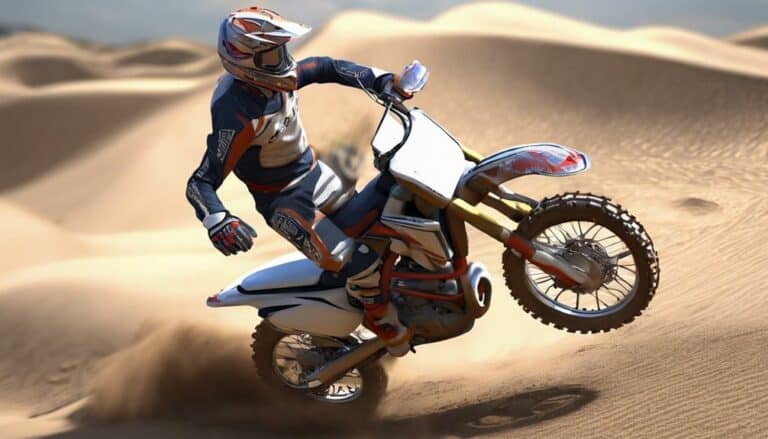Did you know that mastering braking on different terrains with a dirt bike can reduce your braking distance by up to 20%?
Understanding how to brake effectively on various surfaces is essential for your safety and performance.
From loose gravel to muddy trails, each terrain demands a different approach to braking.
So, how can you guarantee you have the skills to handle any surface with confidence and control?
Key Takeaways
- Adapt braking techniques for varied terrains to maintain control and safety.
- Identify visual markers for consistent braking zones on different surfaces.
- Anticipate braking needs for diverse terrains to ensure performance consistency.
- Optimize foot positioning to enhance braking effectiveness across various terrains.
Attack Position for Braking
When braking on different terrains with a dirt bike, mastering the attack position is important for best control and balance.
The attack position is fundamental for honing your braking skills and technique. By adopting this stance, you align your body with the bike, enhancing stability and control during braking maneuvers.
Keeping your elbows up and knees bent allows you to shift your weight effectively, preparing you to respond swiftly to changes in terrain. This position also aids in absorbing impacts and maintaining control over rough surfaces.
The attack position isn't only about posture but also about building muscle memory for efficient braking responses. As you practice this technique, you develop the ability to handle braking across various terrains with ease and confidence.
Engine Braking Techniques
Utilize engine braking techniques on your dirt bike to enhance control and optimize deceleration across diverse terrains. Engine braking involves releasing the throttle without engaging the clutch, leveraging the engine's resistance to slow down the bike effectively. Here are some tips to master engine braking techniques:
- Downshifting: Coordinate downshifting to match engine speed with road speed, ensuring smoother deceleration and preventing wheel lock-ups on challenging terrains.
- Gear Ratios: Understand your dirt bike's gear ratios and engine power to utilize engine braking more efficiently, adapting to varying terrain conditions for peak performance.
- Rear Brake: Combine engine braking with the rear brake for enhanced control, distributing braking force between the engine and the rear wheel to stabilize the bike.
- Front Brake: Use the front brake judiciously in conjunction with engine braking, balancing deceleration forces to prevent skidding and maintain steering control, especially on slippery surfaces.
Foot Positioning Importance
Understanding the correct foot positioning plays a pivotal role in maximizing stability and control while braking on various terrains with your dirt bike. Proper foot placement, such as sliding your foot slightly forward with a locked knee, is essential for enhancing stability during braking.
By positioning your foot effectively, you can distribute weight effectively, improving control and reducing the risk of skidding or losing balance. Gripping the bike with your knees and adjusting your foot placement enables you to better manage the bike's response to different terrain conditions while braking.
This technique not only supports control and balance but also enhances your ability to adapt and respond effectively to challenging surfaces. Remember, the way you position your feet can have a significant impact on your braking performance, both with the front and rear brakes.
Mastering the art of foot positioning will empower you to navigate diverse terrains with confidence and skill.
Balancing Front and Rear Brakes
To achieve peak stability and control across diverse terrains with your dirt bike, mastering the balance between front and rear brakes is essential. When the brake is applied, remember the following to maximize your braking efficiency:
- Simultaneous Braking: Applying both brakes simultaneously helps distribute braking force effectively, enhancing control and stability.
- Rear Brake Anchoring: The rear brake acts as an anchor, stabilizing the bike during braking and preventing excessive weight shift to the front.
- Adjust Brake Pressure: Adjust brake pressure to prevent nose diving or skidding on various surfaces, ensuring a smooth and controlled stop.
- Moderate Rear Brake Application: Practice moderate rear brake application to prevent wheel chatter, which can enhance stability by keeping the bike from sliding too much rear.
Developing Braking Zone
Developing your dirt bike successfully through various terrains requires mastering the art of developing braking zones. When it comes to off-road riding, knowing where braking occurs and establishing the right starting point for braking can make a significant difference in your performance. By identifying braking zones based on terrain features like bumps, ruts, and corners, you can anticipate when and where you will need to brake.
To help you visualize this concept better, here's a table outlining some key aspects of developing braking zones:
| Aspect | Description | Importance |
|---|---|---|
| Terrain Features | Bumps, ruts, corners – Identify these to anticipate the need for braking. | Critical for safety |
| Adjusting Techniques | Modify braking for different terrains like loose dirt, rocks, mud, or sand to optimize grip and control. | Enhances control |
| Visual Markers | Use markers or reference points to establish consistent braking zones for improved performance on the track/trail. | Ensures consistency |
Conclusion
In mastering braking on different terrains with a dirt bike, remember that balance is key.
Did you know that professional riders adjust their brake pressure based on the terrain up to 50 times per minute? This constant adaptation guarantees peak performance and control.
By honing your skills in the attack position, utilizing engine braking, and maintaining proper foot positioning, you can navigate any terrain with confidence and precision.
Keep practicing and refining your techniques to become a skilled dirt bike rider.

